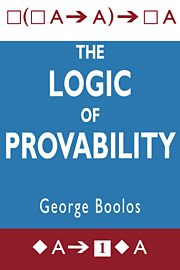Book contents
- Frontmatter
- Contents
- Preface
- Introduction
- 1 GL and other systems of propositional modal logic
- 2 Peano arithmetic
- 3 The box as Bew(x)
- 4 Semantics for GL and other modal logics
- 5 Completeness and decidability of GL and K, K4, T, B, S4, and S5
- 6 Canonical models
- 7 On GL
- 8 The fixed point theorem
- 9 The arithmetical completeness theorems for GL and GLS
- 10 Trees for GL
- 11 An incomplete system of modal logic
- 12 An S4-preserving proof-theoretical treatment of modality
- 13 Modal logic within set theory
- 14 Modal logic within analysis
- 15 The joint provability logic of consistency and ω-consistency
- 16 On GLB: The fixed point theorem, letterless sentences, and analysis
- 17 Quantified provability logic
- 18 Quantified provability logic with one one-place predicate letter
- Notes
- Bibliography
- Index
- Notation and symbols
1 - GL and other systems of propositional modal logic
Published online by Cambridge University Press: 08 January 2010
- Frontmatter
- Contents
- Preface
- Introduction
- 1 GL and other systems of propositional modal logic
- 2 Peano arithmetic
- 3 The box as Bew(x)
- 4 Semantics for GL and other modal logics
- 5 Completeness and decidability of GL and K, K4, T, B, S4, and S5
- 6 Canonical models
- 7 On GL
- 8 The fixed point theorem
- 9 The arithmetical completeness theorems for GL and GLS
- 10 Trees for GL
- 11 An incomplete system of modal logic
- 12 An S4-preserving proof-theoretical treatment of modality
- 13 Modal logic within set theory
- 14 Modal logic within analysis
- 15 The joint provability logic of consistency and ω-consistency
- 16 On GLB: The fixed point theorem, letterless sentences, and analysis
- 17 Quantified provability logic
- 18 Quantified provability logic with one one-place predicate letter
- Notes
- Bibliography
- Index
- Notation and symbols
Summary
We are going to investigate a system of propositional modal logic, which we call ‘GL’, for Gödel and Löb. GL is also sometimes called provability logic, but the term is also used to mean modal logic, as applied to the study of provability. By studying GL, we can learn new and interesting facts about provability and consistency, concepts studied by Gödel in “On formally undecidable propositions of Principia Mathematica and related systems I”, and about the phenomenon of self-reference.
Like the systems T (sometimes called ‘M’), S4, B, and S5, which are four of the best-known systems of modal logic, GL is a normal system of propositional modal logic. That is to say, the theorems of GL contain all tautologies of the propositional calculus (including, of course, those that contain the special symbols of modal logic); contain all distribution axioms, i.e., all sentences of the form □(A→B)→(□A→□B); and are closed under the rules of modus ponens, substitution, and necessitation, according to which □A is a theorem provided that A is. Nor does GL differ from those other systems in the syntax of its sentences: exactly the same sequences of symbols count as well-formed sentences in all five systems.
GL differs greatly from T, S4, B, and S5, however, with respect to basic questions of theoremhood. All sentences □(□A→A)→□A are axioms of GL.
- Type
- Chapter
- Information
- The Logic of Provability , pp. 1 - 14Publisher: Cambridge University PressPrint publication year: 1994



